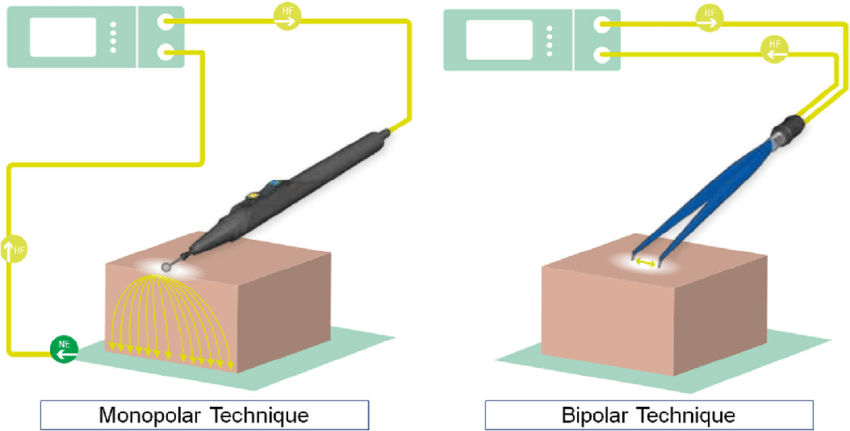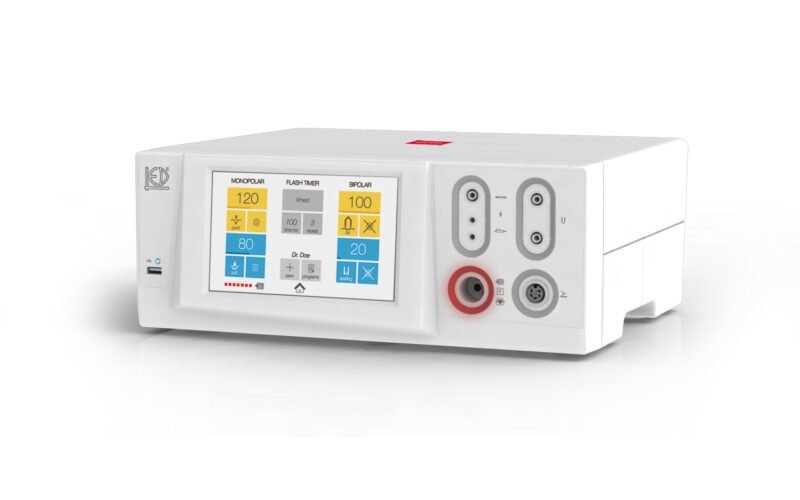High-frequency power supply for electrosurgery refers to alternating current (AC) signals with high power and high frequency to raise tissue temperature to the point where coagulation or drying can occur from vaporization. Due to the phenomenon of tissue cutting, hemostasis, blocking structures with lumens, and removal of significant amounts of tissue are all accomplished.
Since the beginning of the 19th century, electrosurgery has become a concept.
High-frequency power supply for electrosurgery concept
High-frequency electricity is used in electrosurgery to sever or coagulate living tissue. The process should not be confused with electrocautery, where the wire is heated rather than the tissue, as with electrocautery. Although the electrodes are cool during electrosurgery, heat develops in the tissue where the current travels. Several factors, including bioimpedance, are at play: Figuring out the RF current’s route and their impact, if any metal implants are present.
•Firstly, modulating the RF output property.
• Moreover, regulating unique coagulation mechanisms.
• Furthermore, safety surveillance of crucial neutral return plate operations.
So, both functions and safety are concerned with bioimpedance participation.
Selecting the appropriate electrosurgical device
Electrosurgical tools are perhaps the most popular and practical pieces of surgical equipment which perform electrosurgery or use High-frequency power supply for electrosurgery to cut or coagulate tissue during surgery. It comprises an Electrosurgical generator that produces HF current from electrical energy. A certain control controls it. An active electrode is connected to the generator. This active electrode is the one that makes contact with the tissue and causes a heating effect. Electrosurgical machines have different electrodes and varied functions depending on the surgical uses.
What varieties of electrosurgical equipment are there?
Surgical equipment categories include radio or high-frequency, ultrasound, and molecular resonance.
- The most popular kind of surgical equipment on the market is radio frequency equipment. They convert mains current into high-frequency current (HF; > 200 kHz).
- Ultrasonic handpieces are use in surgical ultrasound units. They have a device to produce ultrasonic waves. While cavitation does the cutting, these ultrasonic waves cause coagulation by breaking the hydrogen bonds of the cells.
- Molecular resonance surgical equipment uses frequencies that interact with tissue without heating it, unlike high-frequency surgical equipment.
What are the primary operating principles of electrosurgical units?
The main purposes of electrosurgical devices are to cut or coagulate tissue using high-frequency power supply for electrosurgery. One can accomplish the cut and coagulation using either a monopolar or bipolar approach. Here are the variations:
Monopolar technique
A single active electrode that also serves as a neutral electrode in the monopolar approach. It transmits the generator’s HF current. High current density is transferred when this electrode makes contact with the tissue. This intense focus of energy on a limited region produces the intended result. The patient’s body then conducts the electricity to the neutral electrode to complete the circuit.
| Benefits | Risks |
| Effective for desiccating bulky tissue masses. | The neutral electrode must be carefully administered to the patient to limit the risk of electrocution. This approach is also incompatible with individuals who have pacemakers or metal implants. |

Bipolar technique
Without passing through the patient’s body, the HF current enters an active electrode and leaves through a neutral electrode. The most popular tool for this method is a pair of bipolar forceps. Direct current travels from one forceps tip to the other. Here, the neutral electrode serves no purpose.
| Benefits | Risks |
| This approach should be utilized for patients with pacemakers as it is safer than the monopolar technique and poses no risk of burning the patient. | Ineffective for desiccating substantial tissue masses |

Which surgical procedures can be performed with High-frequency power supply for electrosurgery ?
Electrosurgical equipment is employed in operating rooms for numerous surgical procedures, including endoscopic, cardiac, dental, and cosmetic surgery.
Endoscopic surgery: Bipolar electrosurgical cutting is frequently utilized in this minimally invasive surgery, which is growing in popularity.
cardiac surgery The principal application of fulguration in heart and liver surgery
Dental surgery: Electrosurgery is performed during dental or oral surgery to halt bleeding and eliminate any exophytic soft tissue tumor forms in the oral cavity.
Cosmetic or dermatological surgery: Electrosurgery includes electrocoagulation for the treatment of rosacea, electric depilation, and skin removal.
What dangers come with using a high power electrosurgical device?
The use of an electrosurgical device carries several dangers. High-frequency generators and their accessories must adhere to the norms for technical equipment with unique dangers. The various dangers are as follows:
- Burned by high frequency.
- Bedsores brought on by the patient’s position during the procedure are occasionally mistaken for burns.
- Fires that start in the operating room as a result of combustible liquids or gasses.
- Electrical risks brought on by improper connections to other equipment.
- Technical issues with faulty attachments or equipment.
What factors will affect the surgical unit’s thermal effect?
Numerous variables, including the strength of the current, the degree of modulation, and the form of the electrode, High-frequency power supply for electrosurgery. The following elements:
- Power production and intensity
- The shape of the HF current pulses depends on the degree of modulation. They are reliant on the generator itself and any potential electrosurgical device settings. The depth of coagulation or the effectiveness of the cut may be influenced by the degree of modulation.
- The electrode’s shape controls the concentration of the field lines at the application location. Consequently, it affects the zone’s temperature and the outcome.
- The condition of the active electrode: by Joule’s law, the anticipated results rely on the resistance level present. Along with the tissue’s inherent resistance, consideration must also be given to any resistance brought on by possible deposits of residue on the active electrode. Therefore, during surgery, electrodes must always be cleaned thoroughly.
- minimizing the intervention’s duration and quickness
- Different forms of tissue offer varying degrees of resistance depending on their physiology.
Conclusion
A High-frequency power supply for electrosurgery performs electrosurgery, which involves cutting or coagulating tissue using high-frequency (HF) electrical currents. A high-frequency power supply for electrosurgery is a therapeutic technique that uses high-frequency magnetic currents for therapeutic strategies and has surgical applications. Higher-frequency electrosurgery is indeed a surgical approach connected to diathermy.
also visit: Medical Applications For a Medical Linear Motor

